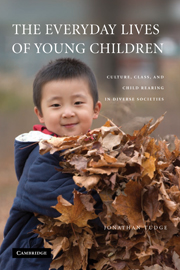Book contents
- Frontmatter
- Contents
- Preface
- Acknowledgments
- 1 Introduction and Stage Setting
- 2 The Daily Lives of Toddlers
- 3 Cultural–Ecological Theory and Its Implications for Research
- 4 Methods
- 5 Life in the Cities
- 6 Everyday Activities
- 7 Settings and Partners
- 8 Everyday Lives
- 9 The Cultural Ecology of Young Children
- References
- Index
9 - The Cultural Ecology of Young Children
Published online by Cambridge University Press: 25 July 2009
- Frontmatter
- Contents
- Preface
- Acknowledgments
- 1 Introduction and Stage Setting
- 2 The Daily Lives of Toddlers
- 3 Cultural–Ecological Theory and Its Implications for Research
- 4 Methods
- 5 Life in the Cities
- 6 Everyday Activities
- 7 Settings and Partners
- 8 Everyday Lives
- 9 The Cultural Ecology of Young Children
- References
- Index
Summary
“Our deeds are fetters that we forge ourselves.” … “Ay, truly: but I think it is the world that brings the iron.”
George Eliot, Middlemarch, 1872/1988, p. 29In the previous three chapters, I've focused on the everyday activities in which young children from different cultural communities are engaged, how they get involved in those activities, the various settings in which they spend their time, and the different people with whom they interact. In this chapter, I return to the earlier discussion of why it's so important to examine these typically occurring activities and interactions, namely, that it is one way in which to understand how culture and human development are related. First, I'll discuss the issues in more abstract ways and then will tie these abstractions to cultural–ecological theory and to the data that have been presented in this book.
CULTURE AND HUMAN DEVELOPMENT
How can we understand the relations between culture and human development? As I described in Chapter 3, the answer to this question depends in large part on one's paradigm, or worldview, and paradigms, as I pointed out in that earlier chapter, vary in terms of ontology, epistemology, and methodology. Ontological questions have to do with the nature of reality. Those who position themselves within the mechanistic paradigm are comfortable with a view that culture (or any aspect of the environment in which people live or are placed, as in the case of experimental research) has a reality separate from that of the individuals within.
- Type
- Chapter
- Information
- The Everyday Lives of Young ChildrenCulture, Class, and Child Rearing in Diverse Societies, pp. 259 - 282Publisher: Cambridge University PressPrint publication year: 2008



